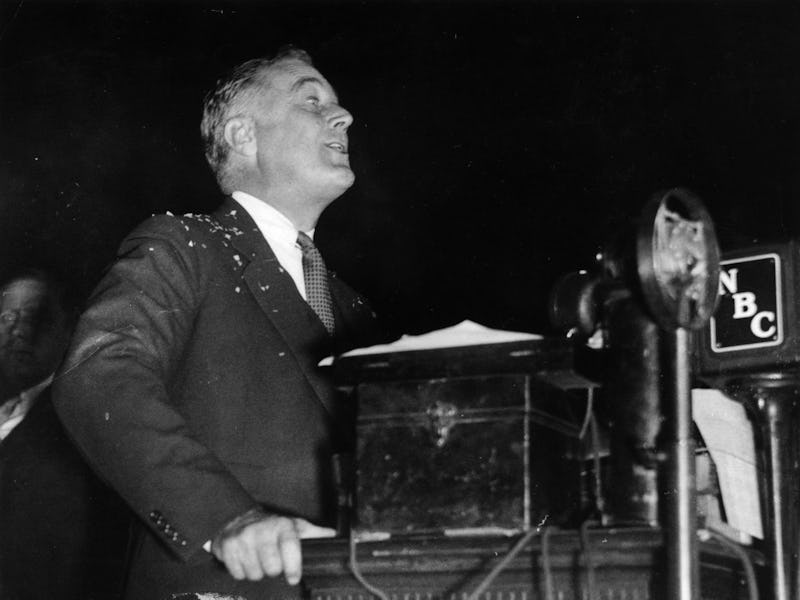This mental health CEO looked to a former leader to inspire his staff
“We had to learn and perfect new ways to connect as a team.”

Dr. Ari Kalechstein looked to the past for inspiration when dealing with the modern challenge of remote work.
“FDR’s brilliant communication strategy was a blueprint for success for our team,” he said. “We are committed to helping others, and that means helping ourselves get through tough times, too.”
Kalechstein started his mental health business, Executive Mental Health (EMH), 24 years ago. Since then, he’s built a network of clinical psychologists and neuropsychologists to serve more than 250 nursing and acute care facilities in California, Nevada, and Alaska. Of course, doctors and therapists typically provide care to patients face to face, but with stay-at-home orders, the company not only had to shift to virtual services but fully remote work among its team as well.
“Our clinicians went in and out of their places of business — in our case, many nursing facilities in California and Nevada — and carried out regular weekly check-ins with their managers,” Kalechstein said. “Just as we transitioned to providing mental health services remotely via telehealth, we also had to learn and perfect new ways to connect as a team.”
Kalechstein’s solution for developing connections? Following in President Franklin D. Roosevelt’s footsteps with regular fireside chats to open up a dialogue with his team.
Here’s how Kalechstein made the change at EMH.
The change
“In March, it was clear it was going to be an extraordinary challenge to manage the business, both on an operational and a human level,” Kalechstein said. “For us, uncertainty was the mother of invention and we literally threw all our irons into the fire. Monday morning management meetings were swapped with twice-daily calls and quarterly full-team gatherings were substituted with weekly fireside chats. Instead of doing the same things remotely, we doubled up and did even more. Our team interactions were different and much more frequent — and even a bit odd at first — but it helped keep the team engaged.”
How it has benefited the company
“Our goal was to retain all of the employees and to refrain from conducting any layoffs,” Kalechstein said. “But equally important were the secondary goals of keeping the team motivated and engaged, and at a physical distance. Fortunately, it worked. Not only did we retain our original team; we were able to increase the size of our staff from 40 people to 60.”
He added, “We worked to maintain the important human connections that had been fostered in the previous years, even in a socially distant environment. In the absence of watercooler moments or after-hours meetings, weekly [video] encounters allowed the team time to communicate weekly successes, shed light on the colleagues responsible for those successes, communicate future goals, and say how they were going to achieve them.”
Dr. Ari Kalechstein is the founder of Executive Mental Health.
The challenges
“The challenge that EMH faced was extraordinary,” Kalechstein said. “We needed to overhaul the care model to telemedicine, and also the way EMH team members interacted with each other, particularly the executive and ancillary staff. Whereas most of us saw each other on a daily, if not weekly, basis before, everyone was now isolated from each other. So the use of telehealth technology, the limitations notwithstanding, were integral to maintaining staff morale and the connections between members of the team.”
He added, “We knew a transition of this magnitude would be stressful for our team, and so we worked hard to maintain warm staff connections and boost their morale. I started by facilitating an open dialogue with them and fostered a sense of hope by describing a concrete pathway to success. Instead of projecting bravado and sureness, I was honest. Like my team, I was at times afraid and unsure, as were most. After that, I was able to present a vision about where the business was and where we wanted to go.”
4 tips from Kalechstein to implement this change
4. “Encourage an open, honest dialogue with your team. Nothing feels worse than when a boss says things aren’t tough, especially when they are. Leadership should pave a pathway for success, and that includes telling your team when they are facing challenges. That honesty creates a sense of trust and enables teammates to prepare mentally and emotionally for the challenge.”
3. “Find new benchmarks for success. When we face challenges, it’s helpful to identify new guideposts/markers for success. Many times, a series of individual intermediate benchmarks are more motivating than a single benchmark of success. This way teams experience success on a more frequent basis and can be commended on their efforts.”
2. “Consider interacting differently and even more than usual. It’s no surprise that the city leaders of New York and California carried out daily briefings on their situations, as doing so fostered both understanding and trust. Because remote work has caused people to feel socially isolated, scared, and lonely, they will appreciate the effort to help them feel interconnected. Effective leaders can strategize proactively to maximize the likelihood that their teams will stay connected, engaged, and focused on the future.”
1. “Share the spotlight. While it is imperative that a leader offer a vision of success that motivates their team, there is great value in providing teammates the opportunity to speak as well. Most everyone has a personal story regarding recent changes in their lives.”
This article was originally published on